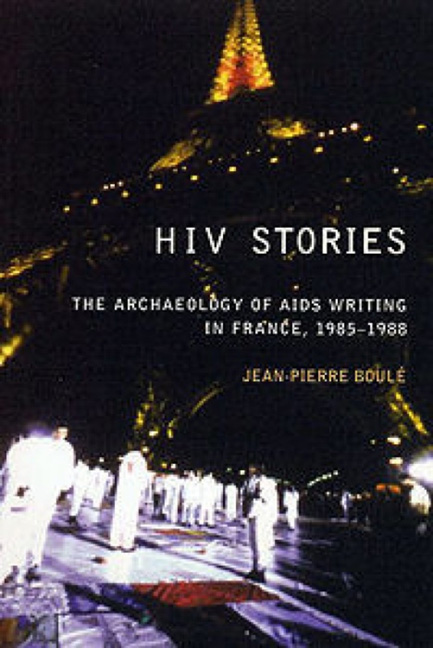1 - Laygues: The Ambiguity in Witnessing
from Part I - AIDS Fiction
Summary
At first glance, Hélène Laygues’ book, Sida, Témoignage sur la vie et la mort de Martin seems to belong to the category of writings classified under the title ‘AIDS and the Culture of Accompaniment in France’, in Ross Chambers's influential article on the subject. Published in 1985, the back cover tells us that the book is original since it is the first time that an account of witnessing (‘témoignage’) is offered by a woman whose husband has contracted the illness. Witnessing implies engagement with a subject rather than detachment, closeness rather than distance. An analysis of the book will establish whether my reading agrees with these suppositions.
Hélène Laygues, the book's author, identifies herself as the first-person narrator. On page 228, she refers to herself as ‘Hélène V.’ as she is introducing herself to another character, which seems to indicate that her surname does not tally with the front cover. In fact Michel Danthe claims that, according to information he obtained from a series editor working for Hachette, a pseudonym was used. This confirms the trend in early AIDS writing in France where authors used pseudonyms because there were a lot of risks involved in using one's own name when talking about a subject which was generating moral panic throughout the world. Though I am aware of the theoretical distinction between the terms ‘author’ and ‘narrator’, I shall refer to Hélène as both the narrative and authorial voice, and take Hélène to represent a female voice (although this particular gender subject-position could be a gender performance), knowing that the subjectivity of ‘Hélène’ is multi-positional, and positioned by particular discourses and practices, not least of which is my own subject-position.
How is the narrative organised? Hélène is the first-person narrator throughout the book. In Chapter 1, we learn that Martin has been dead for a year, as Hélène is relaxing with Paul, her best friend. A phone call in English interrupts their evening; ‘Julian H.’ an American whom Martin had met in New York wants a bed for the night, unaware that Martin is dead. They invite him in for a drink, and Hélène, referring to herself as Martin's wife, gets Paul to tell Julian in English that he has died from AIDS, inviting him in turn to be tested.
- Type
- Chapter
- Information
- HIV StoriesThe Archaeology of AIDS Writing in France, 1985–1988, pp. 31 - 45Publisher: Liverpool University PressPrint publication year: 2002

